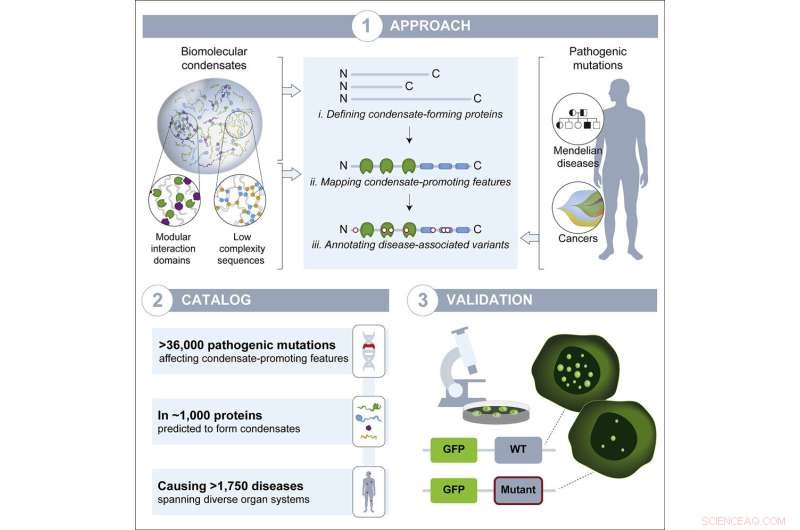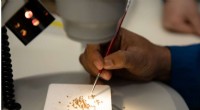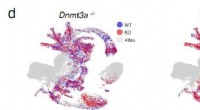Hvordan proteiner samles kan have en undervurderet rolle i sygdom

Grafisk abstrakt. Kredit:Udviklingscelle (2022). DOI:10.1016/j.devcel.2022.06.010
Takket være fremskridt inden for genomik i de seneste årtier kender forskerne nu de genetiske mutationer, der er ansvarlige for mange sygdomme. Men forskerne ved ofte stadig ikke, hvordan mutationen fører til sygdommen - hvad den ændrer inde i cellerne for at forårsage symptomer. At finde ud af denne manglende brik, sygdomsmekanismen, fremmer ikke kun forståelsen af sygdommen, men kan være afgørende for at udvikle en behandling eller forebyggelse. For eksempel, hvis forskere ved, at en mutation fører til skabelsen af et defekt protein, og at opbygningen af dette defekte protein forårsager sygdommen, så kan de designe lægemidler, der vil føre til proteinets ødelæggelse.
Forskere i Whitehead Institute-medlem Richard Youngs laboratorium har studeret en proces kaldet biomolekylær kondensering, der hjælper med at organisere, hvor molekyler ender i celler, og de havde mistanke om, at forstyrrelse af denne proces kunne være en undervurderet, almindelig sygdomsmekanisme. Kondensater er strukturer, der dannes, når mange molekyler løst griber sammen for at skabe en dråbe, der adskilles fra det øvrige indhold af cellen, som en oliedråbe suspenderet i vand. The Young labs seneste forskning, offentliggjort i Developmental Cell den 8. juli, tyder på, at forstyrrelse af kondensater faktisk er gennemgående på tværs af sygdomstyper i hele kroppen. Papiret giver forskere et katalog over sandsynlige tilfælde. De håber, at dette katalog vil blive brugt til yderligere forståelse af sygdomme, hvor kondensat spiller en rolle, og i sidste ende til at udvikle nye terapier for disse sygdomme.
Voksende bevidsthed om kondensatbiologi
Kun visse molekyler - nogle proteiner og RNA'er - danner kondensater, fordi de indeholder områder, der er i stand til løst at binde sammen. De fleste proteiner har områder, der kun binder meget stærkt til specifikke molekyler, som en nøgle, der går godt ind i en lås. Kondensatdannende proteiner har i stedet en tendens til at skabe masser af løse, mindre specifikke forbindelser med hinanden, der griber sammen i høje koncentrationer, indtil de danner en dråbe. Celler bruger kondensater til at samle molekyler, hvor de er nødvendige i cellen - for eksempel kan molekyler, der er nødvendige for at transskribere gener, danne kondensater i nærheden af disse gener.
Kondensatforskere, herunder Young, som også er professor i biologi ved Massachusetts Institute of Technology, har i de senere år vist, at kondensat spiller en rolle i mange vigtige cellulære processer. Condensate disruption has also been shown to occur in a small but growing number of diseases, in particular neurodegenerative disorders. However, when researchers are hunting for disease mechanisms, condensate disruption is not often considered. Given how commonly condensates play a role in healthy biology, Young lab researchers suspected that their disruption might be common in disease. Postdoc in the Young lab and co-first author Salman Banani, who is also a pathologist at the Brigham and Women's Hospital, began suspecting as much during his clinical training, while looking at genetic sequencing data for cancer patients.
"The goal was to assess the clinical relevance of the mutations in the tumors' genomes and how that might impact care for each patient. I noticed that many of the mutations I was examining were suspiciously affecting regions of the protein that I thought might be involved in condensation," Banani says. "That led me to wonder how often human disease mutations affect condensate forming regions, if we had overlooked a potentially widespread cause of human disease, and whether pathologists should consider condensation properties in any of our assessments of mutations."
When Banani joined the Young lab, the potential clinical significance of mutations in condensate-forming proteins was fresh on his mind. Graduate students in the Young lab and co-first authors on the paper Lena Afeyan and Susana Wilson Hawken, who had been studying how drugs interact with condensates, were also eager to tackle the question of how broadly condensates contribute to disease.
Condensates and disease
The researchers compiled a list of proteins thought to form condensates, and mapped the locations of condensate-forming regions within each protein. They also made a list of genetic mutations known to cause or contribute to a wide variety of diseases, including diseases in which a mutation to a single gene is responsible for the disease and a number of cancers. Next, the researchers mapped each mutation to the part of each protein it affects. From this work, they created a list of disease-causing mutations that occur within the condensate-forming regions of the proteins. They hypothesized that these mutations would be most likely to affect the proteins' ability to form condensates.
The researchers ended up with a catalog of more than 36,000 disease-causing mutations, affecting more than 1,000 proteins, that likely disrupt condensates. The mutations in the catalog contribute to more that 1,700 diseases, including more than 550 cancers, collectively affecting every part of the body. Now, the researchers hope, people studying those diseases can use their catalog as a jumping off point to test if condensate disruption may in fact be a mechanism underlying the disease. This may in turn provide opportunities to develop therapies that target condensates.
"If we now know that a mutation affects a protein that likely resides in a condensate, we can test in cells to see whether and how the mutation affects the condensates and whether this effect is relevant for the underlying disease," Wilson Hawken says. "Then we could test a panel of drugs to see if we could rescue normal condensate formation and if this would be a good way to treat that particular disease."
The researchers tested a sample of the proteins and mutations from their catalog to verify that the catalog is a good predictor of mutations that disrupt condensates. They selected thirteen proteins that are able to form condensates in mouse embryonic stem cells, and introduced relevant disease-causing mutations to the proteins within those cells. Of the fifteen mutations they introduced, thirteen disrupted condensates; this high rate of disruption suggests that the catalog is a strong predictive tool.
Interestingly, different mutations disrupted condensates in different ways. The most common effect was to reduce the proteins' ability to join condensates. However, one mutation instead increased the proteins' ability to join condensates, and another affected where the condensates ended up in cells—all over the cell instead of contained within the nucleus. Determining the specific way in which a mutation affects condensates will be important for understanding disease mechanisms and developing drugs to reverse the mutation's effects.
"This catalog is a great starting point to ask lots of questions about condensate dysregulation as a disease mechanism, such as how do changes in the properties of condensates affect the cellular processes happening in these condensates? We and others believe condensates could have profound implications for disease and drug development, just as they have had in basic molecular biology, and our hope with this catalog is that we can lower the barrier to entry for many more disease researchers to start studying them," Afeyan says.
The researchers hope that their catalog proves useful in others' research, and they also hope that it raises awareness of the likely pervasiveness of condensate dysregulation in diseases, even beyond the instances in the catalog.
"There are likely many cases not covered by the catalog, such as when the mutation does not directly affect the condensate-forming protein, but rather affects one of its regulators," Young says. "I think we are just seeing the tip of the iceberg in terms of the prevalence of condensate dysregulation in disease. My vision for the future is that researchers will consider a condensate model among the conventional models when searching for the potential underlying disease mechanism of any mutation."
Sidste artikelHvilken værdi ved naturen? Lande har nu 1. retningslinjer
Næste artikelSover ulve som hunde?
 Varme artikler
Varme artikler
-
 Dokumentering af verdens afgrødediversitet og gør den tilgængeligEURISCO dokumenterer afgrødediversitet, herunder forskellige sorter af byg, på billedet. Kredit:Nora Capozio Genbanker spiller en vigtig rolle i den langsigtede bevarelse af plantegenetiske ressour
Dokumentering af verdens afgrødediversitet og gør den tilgængeligEURISCO dokumenterer afgrødediversitet, herunder forskellige sorter af byg, på billedet. Kredit:Nora Capozio Genbanker spiller en vigtig rolle i den langsigtede bevarelse af plantegenetiske ressour -
 Forskere identificerer skjult genetisk variation, der hjælper med at drive evolutionenFørsteforfatter Mahul Chakraborty ser gennem flere eksemplarer af frugtfluer for at identificere nye fænotyper. Kredit:UCI Det har været vanskeligt at identificere komplekse mutationer i strukture
Forskere identificerer skjult genetisk variation, der hjælper med at drive evolutionenFørsteforfatter Mahul Chakraborty ser gennem flere eksemplarer af frugtfluer for at identificere nye fænotyper. Kredit:UCI Det har været vanskeligt at identificere komplekse mutationer i strukture -
 Kropsdele og funktionerDen menneskelige krop er en utrolig biologisk maskine; det består af næsten 100 billioner celler (og indeholder mindst 10 gange så mange bakterier). Nogle af de vigtigste dele af kroppen er knoglesyst
Kropsdele og funktionerDen menneskelige krop er en utrolig biologisk maskine; det består af næsten 100 billioner celler (og indeholder mindst 10 gange så mange bakterier). Nogle af de vigtigste dele af kroppen er knoglesyst -
 Enkeltcelleforskning sætter fokus på rollen som DNA-methylering i beslutninger om celleskæbneKortlægning af celler fra DNMT-knock-out-muselinjerne til referenceatlaset (grå) med vildtypeceller angivet med blåt og knock-out-celler angivet med rødt. Kredit:Babraham Institute Forskning med an
Enkeltcelleforskning sætter fokus på rollen som DNA-methylering i beslutninger om celleskæbneKortlægning af celler fra DNMT-knock-out-muselinjerne til referenceatlaset (grå) med vildtypeceller angivet med blåt og knock-out-celler angivet med rødt. Kredit:Babraham Institute Forskning med an
- Dekontaminering af mandler og nødder med komprimeret kuldioxid
- Trumps foreslåede EPA-nedskæringer ville have ufattelig effekt, siger folkesundhedsekspert
- Tidsoverførselsydelsen for BDS-3-satellitter blev forbedret
- Et stigende antal stater kalder porno for en folkesundhedskrise
- Åben hob NGC 2158 undersøgt i detaljer
- Forklaring af cellespecialisering


